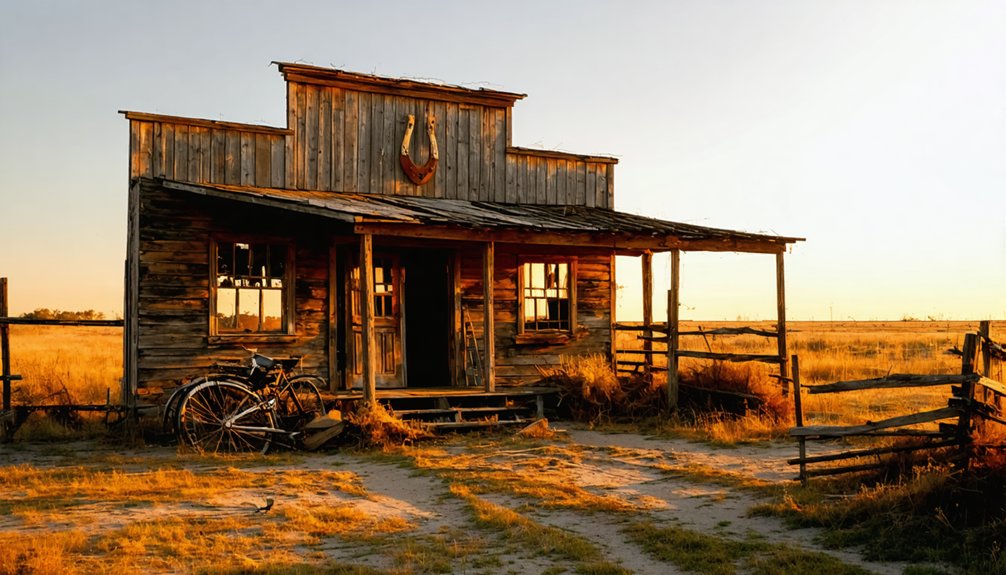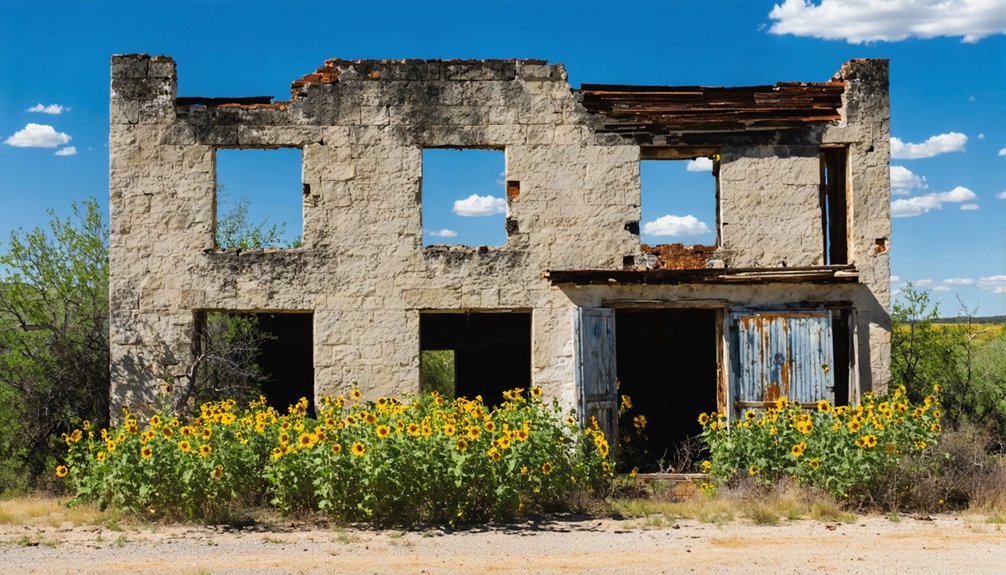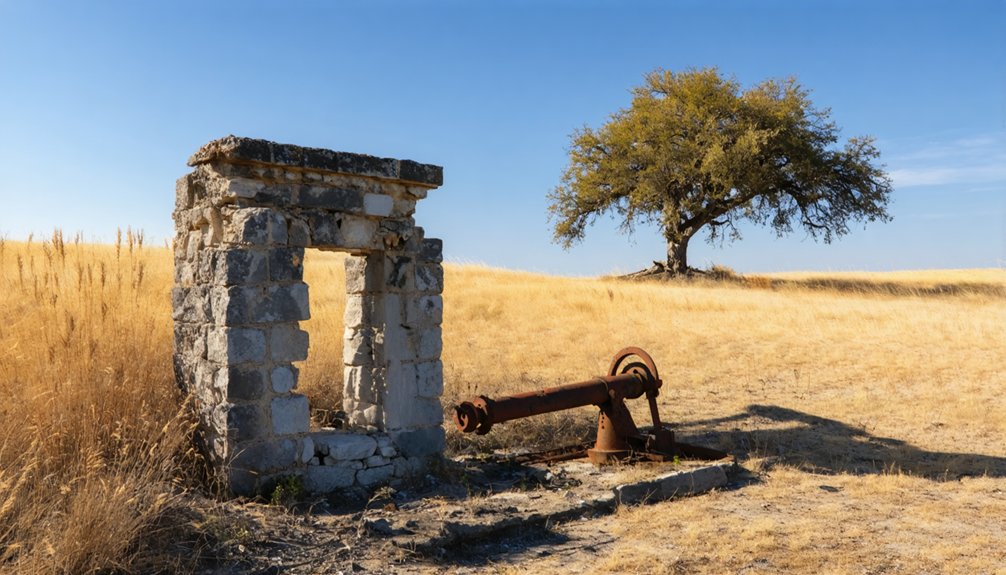You’ll find Shannon in the Texas Panhandle, established in 1878 when Rachel D. Ivie opened a general store at Stampede Springs. The town grew with Mormon settlers arriving in 1900, building a chapel that became the community hub. Today, remnants include weathered ruins, mining equipment, and a historic cemetery. The ghost town‘s most intriguing features connect to Baby Head Mountain, where frontier legends and reported paranormal activity await exploration.
Key Takeaways
- Established in 1878 by Rachel D. Ivie with a general store at Stampede Springs, Shannon became a thriving Texas Panhandle community.
- Mormon settlers transformed the town in 1900, building a chapel that became a central community hub.
- Population declined dramatically from 82 students in 1910 to just 23 residents by the late 1970s.
- Historic ruins include the Mormon chapel, building foundations, and scattered mining equipment behind protective fencing.
- Located near Baby Head Mountain, the ghost town features tragic local legends and is considered spiritually significant to Native Americans.
Origins and Early Settlement
While many Texas frontier settlements emerged during westward expansion, Shannon’s story began specifically in 1878 when Rachel D. Ivie established a general store at what was then called Stampede Springs.
You’ll find that this store quickly became the heart of early commerce and social life, drawing settlers to the Texas Panhandle’s rugged landscape. The settlement later adopted its permanent name from John Moore Shannon, an early pioneer in the area.
The pioneer lifestyle centered around the store, where local farmers and ranchers would gather to trade goods and share news. Like the legendary horse that detected quicksand at another Texas settlement, Shannon’s store provided a vital service to the community.
These first inhabitants, mainly Anglo-American settlers seeking new opportunities, built dispersed homesteads across the prairie while maintaining connections through the trading post. They cultivated the land and raised livestock, establishing the foundations of a frontier community that would grow through the 1880s. By 1887, Joe Shannon built the first permanent house in the settlement, marking a significant milestone in the town’s development.
Mormon Heritage and Religious Life
The religious landscape of Shannon underwent a significant transformation in 1900 when a group of Mormon settlers arrived and established their presence in the frontier community.
You’ll find that their first major project involved building a small frame chapel on land donated by Shannon himself, creating a central hub for Mormon traditions and religious gatherings.
Like other Mormon settlements in Central Texas, such as the now-vanished Port Sullivan, Shannon’s Mormon community brought with them distinct cultural practices and agricultural expertise. These families maintained historical connections with their Utah roots while establishing new lives in Texas. The settlers organized their group into fourteen companies, following the organizational structure that had proven successful during earlier Mormon migrations.
Mormon settlers enriched Central Texas communities like Shannon and Port Sullivan with their unique farming methods and cultural traditions.
They organized structured communal activities and emphasized education, which enriched the town’s social fabric.
Their chapel served as more than just a place of worship – it became a cornerstone for community life, fostering social bonds and interfaith relationships that would shape Shannon’s development in the early 20th century.
Geographic Features and Landmarks
Situated in arid West Texas, Shannon’s desert plains stretch across a stark landscape where sparse vegetation and rocky outcrops punctuate the horizon.
You’ll find desert ecology at work around a small spring that sustains scattered trees, providing a rare oasis in this harsh environment of extreme temperatures and minimal rainfall.
The town’s mining legacy dominates the terrain through scattered industrial remnants and rusting machinery.
You can spot old mining foundations and weathered equipment near a windmill, evidence of past water-pumping operations.
While formal landmarks are few, the decaying wooden structures and metal-framed buildings serve as historical markers themselves.
A notable cistern, once essential for rainwater collection, stands among the ruins, though protective fencing and no-trespassing signs now limit access to these fragile remains, similar to the old cistern preserved at Indianola.
The view extends to the picturesque Three Sisters mountains in the distance.
Population Changes Through Time
Although precise early population figures remain elusive, Shannon’s demographic story reveals itself through school enrollment data, which showed 82 students in 1910, suggesting a robust community at the time.
The dramatic population decline that followed transformed this once-vibrant town into a shadow of its former self. To avoid confusion with other places named Shannon, local historians ensured accurate documentation of population changes. Significant demographic shifts occurred throughout the mid-20th century, with major changes including:
- Sharp drop to approximately 80 residents by 1966-67
- Further decrease to just 23 residents in the late 1970s
- Population remained stagnant at 23 through 1990 and 2000
- Rural-to-urban migration drew families to larger cities
- Economic changes and limited infrastructure hastened the decline
Prior to the decline, the town maintained a steady population of 112 residents throughout the mid-1920s and for three subsequent decades.
Today, Shannon stands as a reflection of the broader pattern of rural depopulation that’s reshaped many Texas communities since World War II.
Buildings and Remaining Structures
As you explore Shannon’s remaining structures, you’ll spot the weathered ruins of a Mormon chapel that once served the town’s religious community.
The historic building foundations scattered across the landscape mark where homes and businesses once stood, though most have crumbled into partial walls and rubble.
Several structures still line the old ranch road, protected behind fencing that preserves these tangible links to Shannon’s past. Much like the town of Old Alton Bridge, only key landmarks and a cemetery remain to mark Shannon’s former presence. The site draws visitors seeking to understand how railroad rerouting and economic changes led to the town’s eventual abandonment.
Mormon Chapel Remains
The decaying remnants of Shannon’s Mormon chapel stand as silent witnesses to the town’s religious heritage, with partial stone walls and foundational fragments marking the site of what was once a vibrant community center.
The chapel’s architectural adaptations reflect the resourcefulness of early Mormon settlers, who used local stone and timber in their frontier construction.
- Original rectangular design featured simple windows and doorframes without an elaborate steeple
- Served as the hub for community worship, baptisms, and social gatherings
- Construction methods mirror early Mormon pioneer practices across Texas
- Weather exposure and lack of preservation have accelerated structural decay
- Site remains largely overgrown but identifiable through masonry debris
Today, while modern LDS buildings in Texas showcase grand architectural styles, Shannon’s modest chapel ruins tell a compelling story of community significance and frontier determination.
Historic Building Foundations
Beyond the Mormon chapel ruins, scattered building foundations tell a deeper story of Shannon’s once-thriving community.
You’ll find historic foundations of general stores, a post office, and even a schoolhouse that served as the town’s social nucleus. These architectural remnants, built from local stone and brick, line what were once bustling dirt roads through the settlement.
Near the natural springs, you can trace the outlines of former homes where families once lived, with deteriorating stone foundations revealing the footprints of porches and small outbuildings.
While many structures have been reduced to rubble, their remains offer glimpses into Shannon’s layout and daily life.
Gates and fencing now protect these significant historic foundations, preserving what’s left of this ghost town’s physical heritage.
Ranch Road Structures
Ranch roads threading through Shannon reveal a collection of weathered structures that hint at the town’s busier days. As you explore the ghost town infrastructure, you’ll find ranch road remnants dotted with abandoned buildings and ruins that tell stories of the town’s past significance.
- Old gas stations and general stores stand as silent sentinels along the dusty routes.
- Natural springs and windmills mark historic water sources, with trees growing nearby.
- Mining equipment and utility structures showcase the area’s resource extraction history.
- Fenced-off buildings display “no trespassing” signs, preserving private property.
- Former community hubs like diners and theaters remind visitors of Shannon’s social life.
These remaining structures, though weathered by time, serve as physical connections to Shannon’s lively ranching and mining heritage.
Local Legends and Folklore

Although Shannon’s most intriguing local lore centers on Baby Head Mountain, you won’t find much documentation beyond whispered tales from former residents about its unusual name’s origins.
You’ll hear stories about the Mormon Chapel that once stood near the mountain’s base, where settlers claimed to witness strange lights and unexplained phenomena during their evening services.
Local folklore also suggests that both the mountain and chapel areas remain spiritually significant to the region’s Native American tribes, who reportedly conducted ceremonies there long before Shannon’s establishment.
Baby Head Mountain Tales
How did a tragic frontier incident give rise to one of Texas’s most haunting place names? In the 1850s, Baby Head Mountain earned its chilling name after Native Americans kidnapped a settler’s child, leading to one of the darkest chapters in Texas Hill Country history.
When pursued by settlers, the kidnappers killed the young girl and displayed her head on a stake at the mountain’s base.
- The mountain’s grim legacy spawned a settlement called Babyhead in the 1870s
- Baby Head Cemetery remains the only visible landmark from this haunted past
- Local folklore tells of eerie traditions, including doll heads hung on cemetery signs
- The mountain stands as a symbol to frontier-era conflicts
- Ghost enthusiasts still visit the site, drawn by its dark historical tragedy
Mormon Chapel Stories
Beyond Baby Head Mountain‘s dark history lies another fascinating chapter of Shannon’s past – the Mormon Chapel stories that weave through local legend.
Mormon folklore tells of early settlers who received donated land to build their chapel, establishing a foothold in this remote Texas outpost. You’ll hear tales of the chapel’s distinctive architecture, which blended traditional Mormon design with local building styles, creating a unique landmark that served as both sanctuary and community center.
The chapel became more than just a religious gathering place – it was where cultures intersected, where missionaries shared their adventures, and where locals and Mormon settlers forged unexpected bonds.
Though the chapel no longer stands, its stories live on through generations of Shannon residents, preserving a remarkable narrative to religious diversity in early Texas.
Neighboring Ghost Towns
While Shannon’s own story of abandonment is compelling, the surrounding Texas landscape harbors numerous ghost towns that paint a broader picture of the region’s settlement history.
You’ll find these neighboring settlements scattered across the Hill Country and beyond, each with its own unique tale of rise and decline.
- Baby Head earned its unusual name from a tragic discovery on its namesake mountain and once boasted a thriving post office and school.
- Neighborsville and Neuse Store stand silent in Comal County, remnants of earlier community life.
- Monte Christo’s mining heritage lives on only in memory.
- Mormon Mill recalls the area’s industrial past.
- Fly Gap survives only through its Nameless Road and cemetery, a reflection of the transient nature of frontier settlements.
Historical Impact on Texas Hill Country

Shannon stands as a quintessential example of the Texas Hill Country‘s settlement evolution, where the interplay of natural resources, religious communities, and economic forces shaped the region’s development.
You’ll find in Shannon’s trajectory a microcosm of cultural evolution that defined many Hill Country communities – from its frontier beginnings as Stampede Springs to its Mormon chapel era, and ultimately its decline.
The town’s settlement patterns mirror the broader transformation of Texas Hill Country, where communities initially flourished around natural springs and through religious congregation bonds.
Like many of its neighboring ghost towns, Shannon’s story demonstrates how rural settlements often struggled to maintain population as urbanization drew residents away.
Rural communities like Shannon faced the inevitable exodus of residents seeking better opportunities in growing urban centers.
Today, Shannon’s legacy helps you understand the delicate balance that determined survival or abandonment in Hill Country’s history.
Frequently Asked Questions
Are There Any Annual Events or Gatherings Still Held in Shannon?
Picture a quiet, deserted Main Street – that’s today’s Shannon. You won’t find any annual gatherings or local traditions here anymore, as the ghost town’s population decline has ended all formal community events.
What Happened to the Original Land Deeds of Shannon’s Earliest Settlers?
You’ll find no definitive record of early settlers’ land deed history in Shannon – documents were likely lost through abandonment, courthouse relocations, natural disasters, or private possession over time.
Can Visitors Legally Explore the Remaining Structures on Private Property?
You can’t legally explore Shannon’s structures without explicit property access permission from current owners. Entering without consent carries serious legal implications and risks criminal trespass charges under Texas law.
Were There Any Notable Businesses or Industries Unique to Shannon?
You won’t find unique historical businesses or industries in Shannon beyond typical agricultural operations. The town’s economy centered on cotton and cattle farming, unlike nearby ghost towns that focused on mining.
Did Shannon Have Its Own Cemetery, and Where Were Residents Buried?
With 311 graves and 104 family names, you’ll find Shannon Cemetery 0.5 miles east of FM 175. Since 1878, it’s served as the community’s primary burial ground, starting with Mary Gibson’s interment in 1879.
References
- https://texashillcountry.com/oddly-named-ghost-towns-texas-hill-country/
- https://www.youtube.com/watch?v=phjUE19A8HM
- http://texasalmanac.com/texas-towns/shannon-0
- https://en.wikipedia.org/wiki/List_of_ghost_towns_in_Texas
- https://texasescapes.com/CentralTexasTownsSouth/Jozye-Texas.htm
- https://texashighways.com/culture/history/what-the-heck-is-a-ghost-town/
- https://www.tshaonline.org/handbook/entries/shannon-tx
- https://www.texasalmanac.com/places/shannon-1
- https://www.texasescapes.com/CentralTexasTownsNorth/Shannon-Texas.htm
- https://www.tshaonline.org/handbook/entries/shannon-thomas-jefferson



